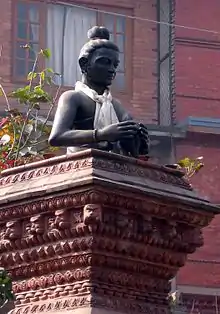Sankhadhar Sakhwa
Sankhadhar Sākhwā (Nepal Bhasa: शंखधर साख्वा:) (also spelt Sankhadhar Sākhwāl) was a legendary[1] Nepalese philanthropist who allegedly paid the debts of the Nepalese people in 879 CE. This event is commemorated as the beginning of the epoch of Nepal Sambat.
Sankhadhar Sakhwa | |
|---|---|
शंखधर साख्वा: | |
 | |
| Born | |
| Resting place | Kathmandu, modern-day Nepal |
According to Bhasa Bamsali and Rajbhogmala Bamsawali, in 879, an astrologer from Bhaktapur predicted sand at the confluence of the Bisnumati and Bhadramati rivers would turn into gold if gathered at the right moment. Raja Ananda Malla, the king of Bhaktapur at the time sent out workers to collect the sand, which was seen by Sākhwā, then a local merchant. He understood that it must be extraordinary sand and he instantly bought it. The next day, Sākhwā found that all the sand had turned into gold, and instead of using the gold for himself, he used it to pay off everyone's debts.[2] On 18 November 1999(2056-08-02 BS), the government declared Sankhadhar Sakhwa as one of the National heroes of Nepal.[3] On 26 October 2003, the Department of Postal Service issued a commemorative postage stamp depicting his portrait.[4]
See also
External links
References
- https://thehimalayantimes.com/kathmandu/sankhadhar-sakhwa-may-never-existed-experts/
- Wright, Daniel (1990). History of Nepal. New Delhi: Asian Educational Services. pp. 163–165. Retrieved 28 April 2014.
- Joshi, Amar Prasad (2008). "Shankhadhar Sakhwa: Founder of Nepal Samvat". The Rising Nepal. Archived from the original on 6 July 2012. Retrieved 23 January 2013.
- "NP010.03". Universal Postal Union. Retrieved 23 January 2012.